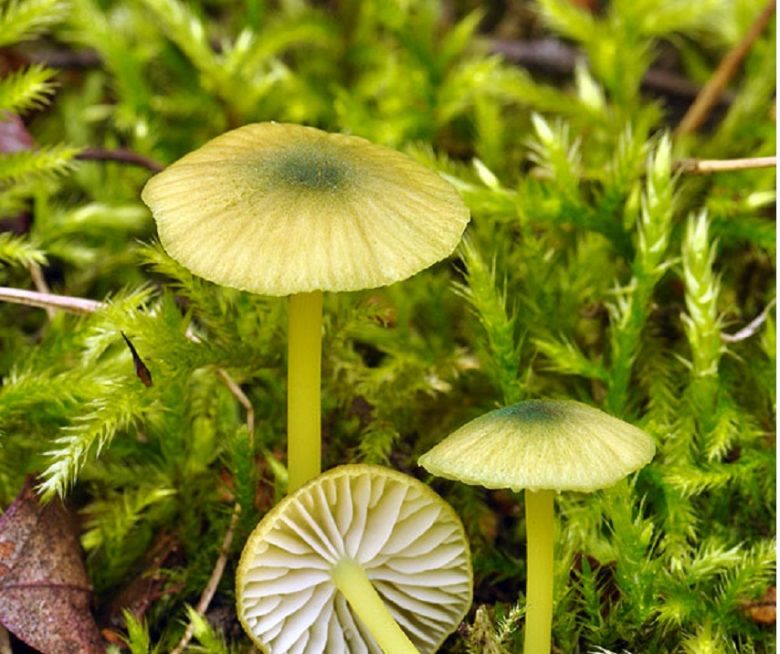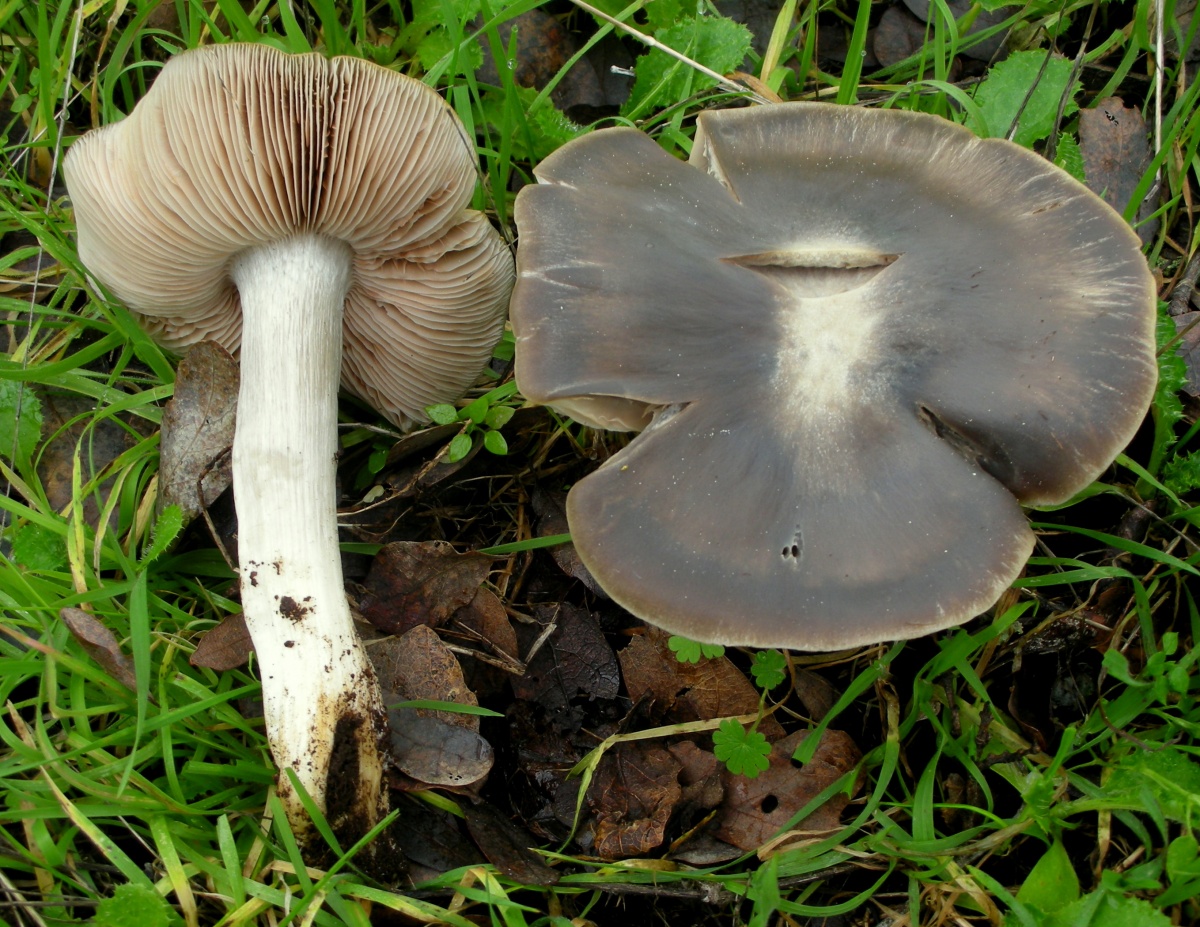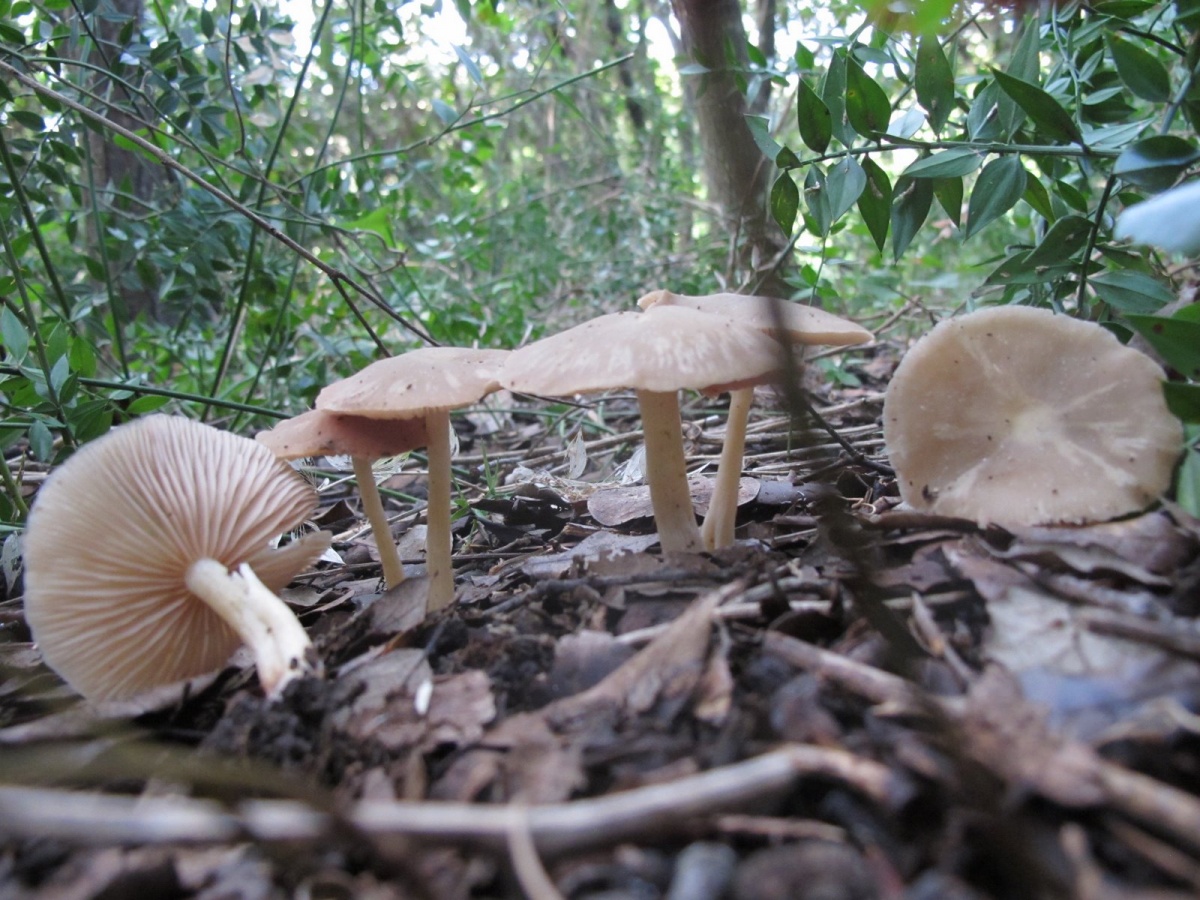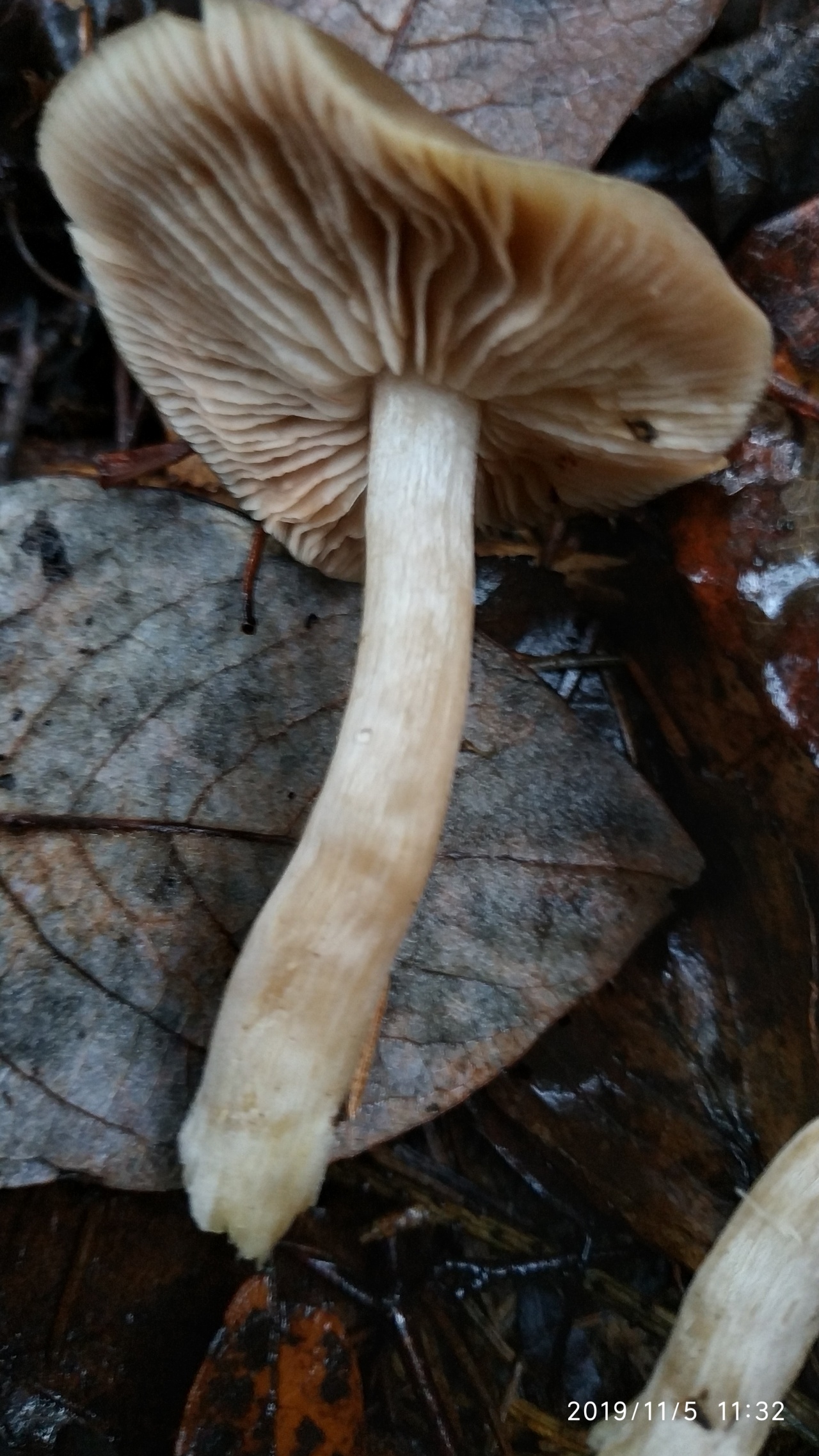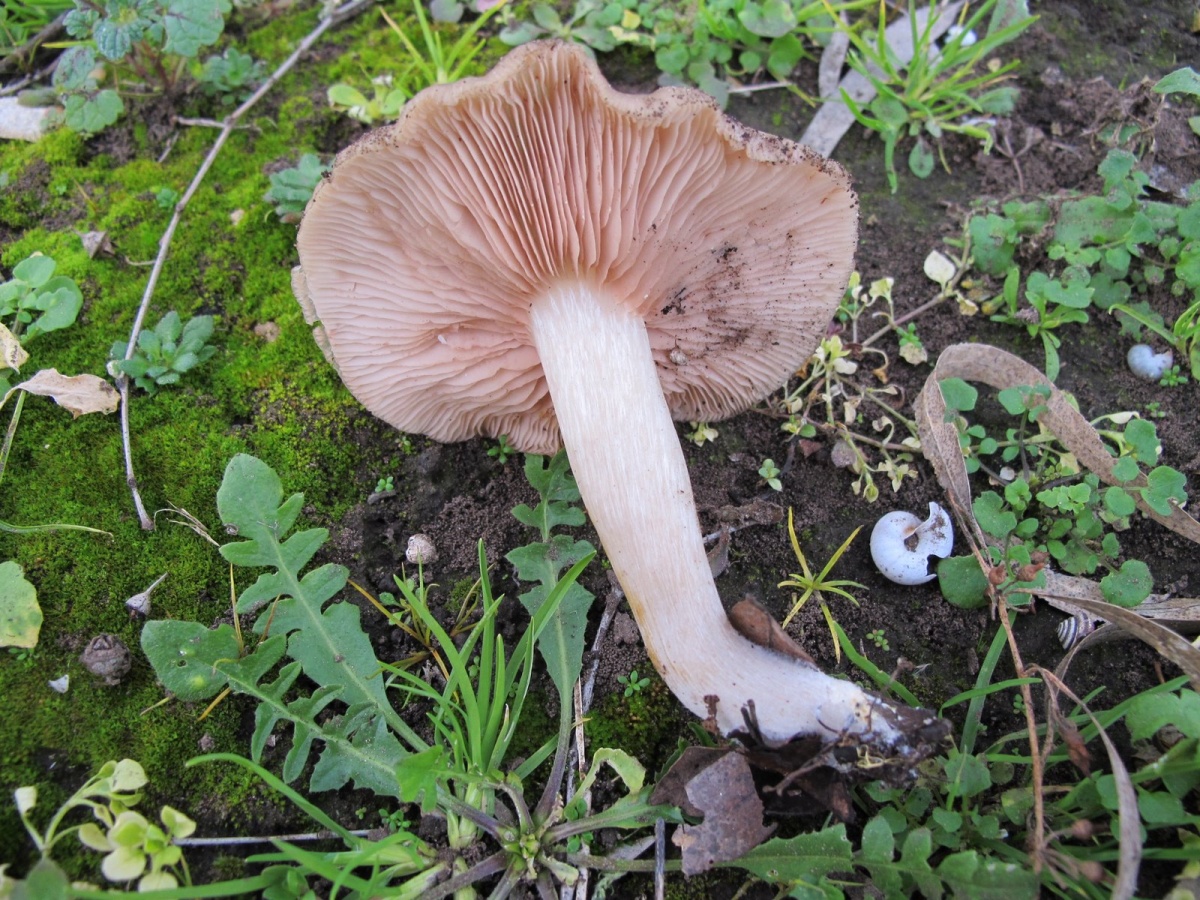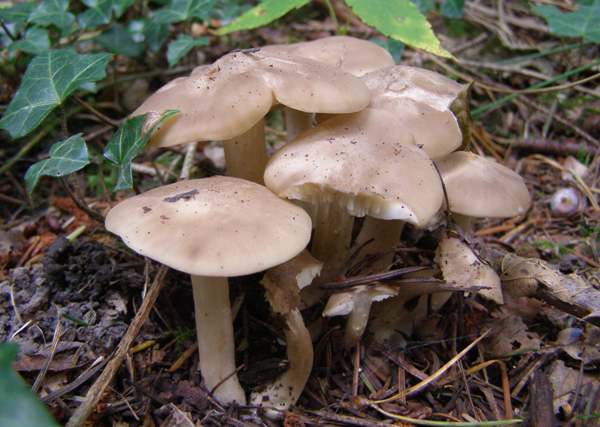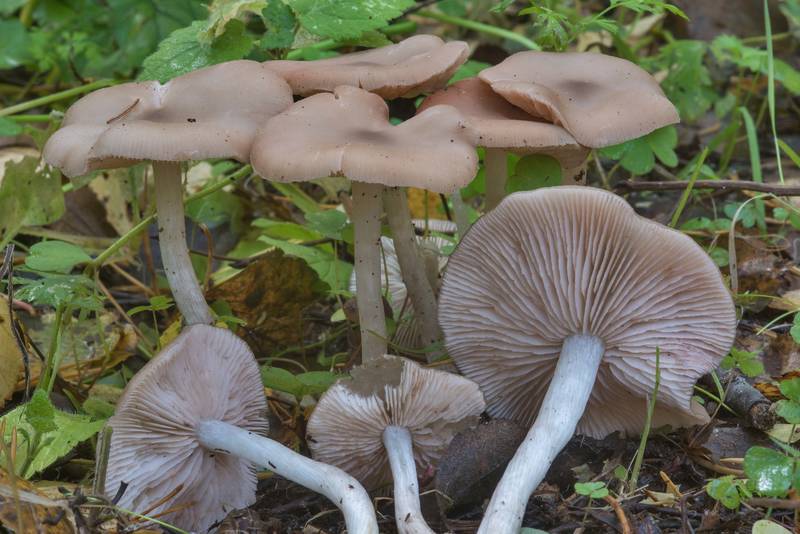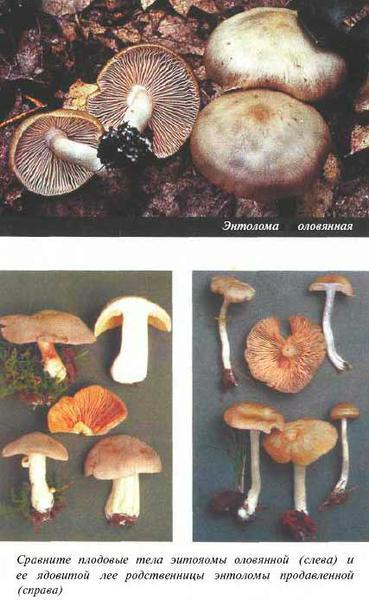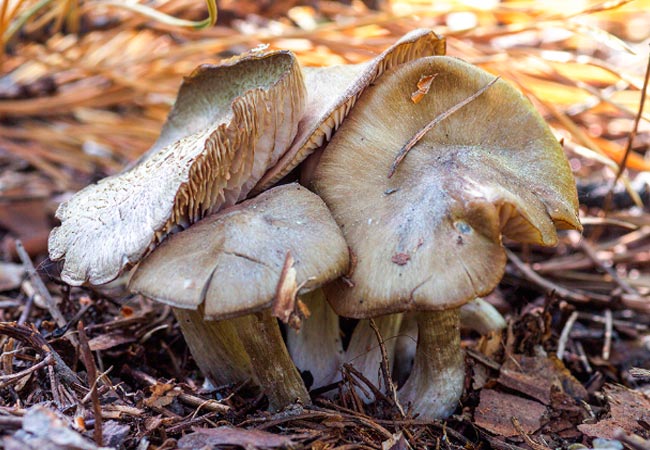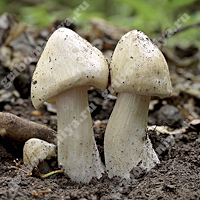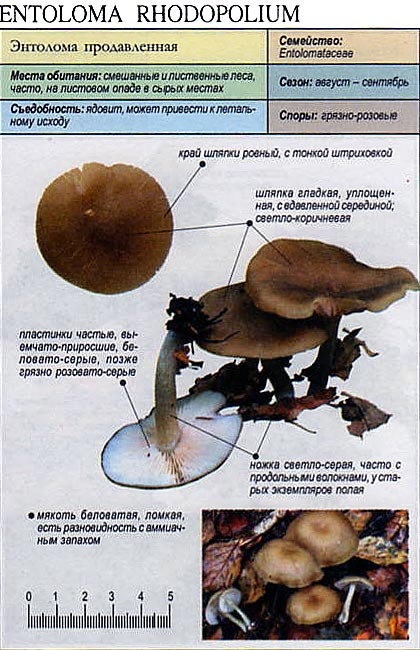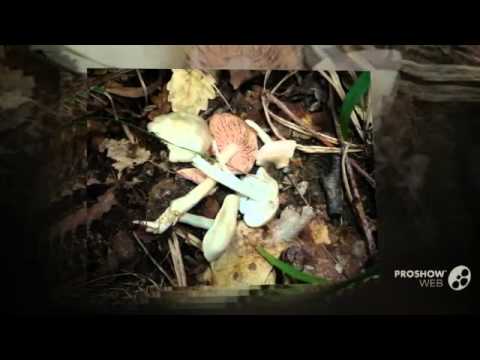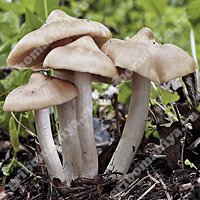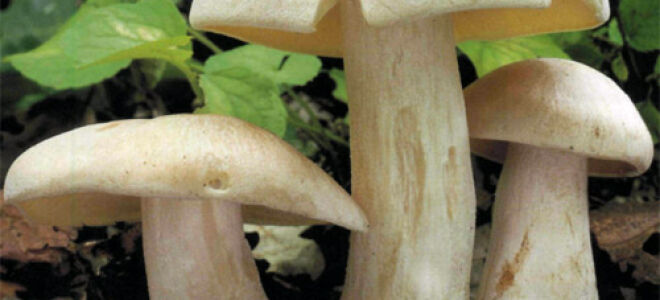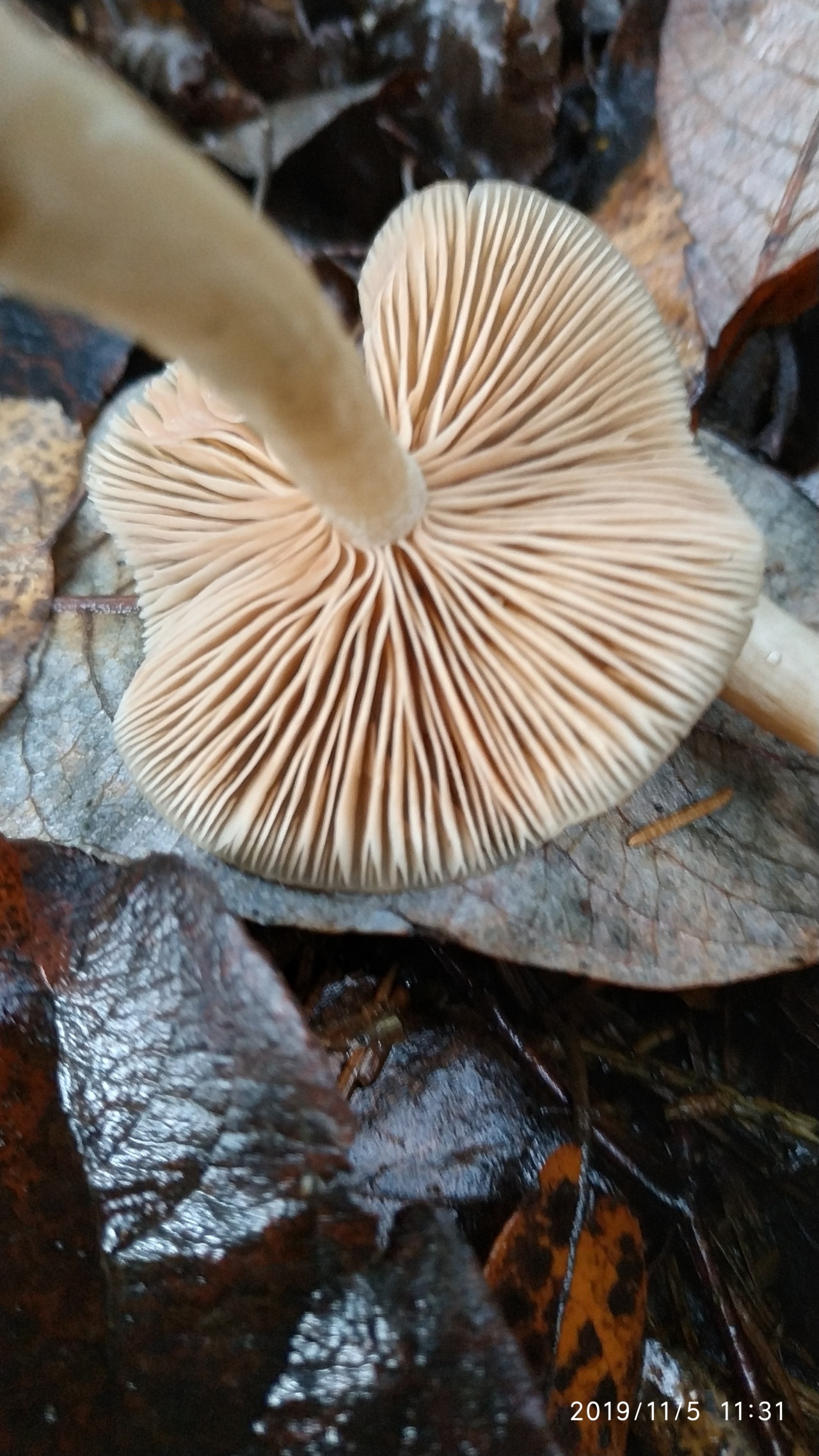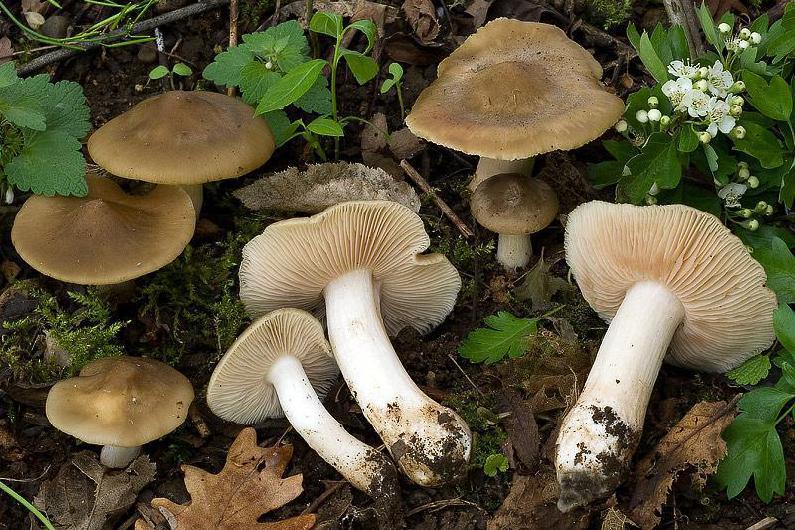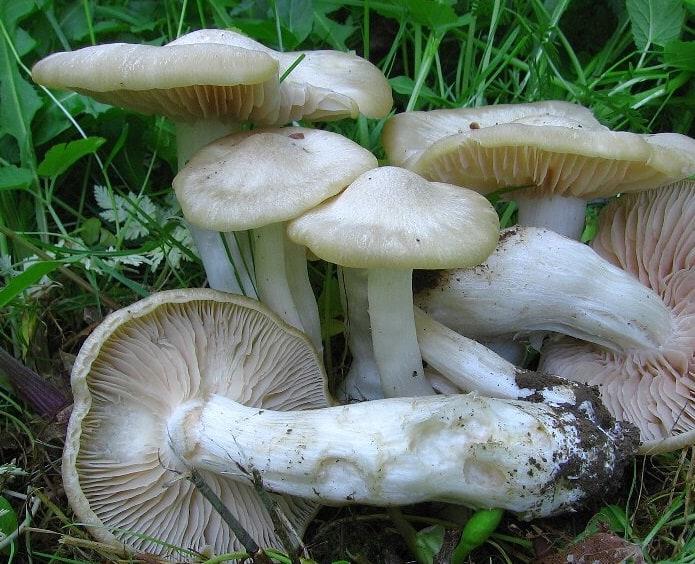Entoloma garden
Garden entoloma - lat. Entoloma clypeatum
In another way, this variety is called Edible Entoloma, Thyroid Pink Platter, Forest Entoloma, Thyroid Entoloma, Podzlivnik, Shield Entoloma, Podzherdelnik, Thorny Entoma or Podbrikosovik.
Translated from Latin, the word "clypeatum" means that the mushroom cap has the shape of a shield.
Mushroom cap
The diameter of the hats of the Edible Entoloma reaches 70-120 mm. Young mushrooms have a hat in the form of a bell-shaped cone or a hemisphere; in adults, it spreads unevenly: some areas become convex, others concave. Darkish mounds remain in the middle of the headdresses. The edges are usually wavy, occasionally fractured.
The surface color is white - gray, pale beige, gray - brown and gray - brown, and varies depending on the weather. On dry days, the hat brightens and remains silky - fibrous, in wet days it becomes sticky and dark.
The hats are filled with taut flesh that softens as it ripens - white or somewhat brown. It often gives off a pleasant mealy smell and tastes similar.
The hat bottom of the thyroid rose-plate is interspersed with wide sparse accrete plates with jagged edges. They differ in different lengths. Young plates are whitish, mature ones are pale pink, grayish pink or gray brown. The lamellar bottoms of old fungi become reddish.
Spores of Entoloma Gardena are in pink powder.
Stipe
The trunk of the Forest Entoloma has a curved cylindrical shape, often twisting. Its diameter is 10-40 mm, height is 100-120 mm. The leg of a young specimen is filled with fragile longitudinally ribbed pulp, but subsequently empties.
The legs of the Subslivnik have a whitish, pale pink or light ash color, at the bottom they are colored lighter. There is no ring.
Entoloma garden (Entoloma clypeatum)
Growing places
Garden entoloma is easy to find on the fertile lands of forests with deciduous trees, where there are birch, mountain ash and oak, even near roads and paths, on meadows and lawns. Also, as the name suggests, it bears fruit well in gardens, under pear and apple trees, pink, thorns, rosehips and hawthorn bushes.
Thyroid entoloma is collected on the North American continent, Ukrainian and Western European lands. In Russia, she inhabits the Leningrad region, in particular, St. Petersburg.
Fruiting usually occurs in numerous groups, extremely rarely - one by one, and falls in April (in warm regions) or June-July (in temperate climates). The mushroom can bear fruit in several stages.
Edibility
Thorny entoloma belongs to conditionally edible mushrooms, suitable for cooking various dishes after twenty minutes of boiling. It is salted and pickled. Western European residents consider this mushroom a delicacy, while residents of southern Russia consider it a traditional food product.
Taxonomy
The species was first mentioned in the city in the work of the French naturalist Pierre Buyard as Agaricus lividus... Later, in the city of Christian Person, for the first time, he describes it as Agaricus sinuatus... Current binomial name Entoloma sinuatum The mushroom was obtained in the work of the German mycologist P. Kummer in the city. Nevertheless, the name given by Pierre Bulliard continued to be widely used in the literature, until it became clear that the illustration of Bulliard depicts not a poisonous rose-plate, but a deer whip. Since Mr. Entoloma sinuatum becomes the generally accepted scientific name of the fungus; title Entoloma lividum with r is considered invalid and is not used synonymously.
Another synonym Rhodophyllus sinuatus, was introduced by the French mycologist Lucien Kehle, in g.combining mushrooms with pink adherent or notched hymenophore plates and angular spores into an alternative genus Rhodophyllus.
Binomen Entoloma eulividum (Bull.) Noordel., 1985 refers to the usual form (subspecies) Entoloma sinuatum - with yellowish plates. Previously, this form was allocated in a separate form, different from Entoloma sinuatum (with discs without yellowish color).
Propagation of buddley by cuttings
Growing buddley from seeds is a more complicated and time-consuming process, in contrast to propagation by cuttings. To carry out cuttings, you must first prepare the material.
You will need young shoots that have grown in the spring of this year.
Their length is at least 15 cm and no more than 20 cm, they should have 3-4 buds. Woody branches that can be cut in the fall are also good options.
Dig a hole and place the shoot there.
The embedment depth is usually 2-3 cm.
The twigs will need 2 months to root.
All this time they are covered with a film, they are removed only when new shoots appear.
Each gardener chooses the breeding method independently, everyone has their own favorite methods.
But regardless of this, it is faster and more reliable to rooting cuttings and germinating seeds at home.
Otherwise, fragile seedlings may suffer from frost.
The easiest way is to take apical cuttings from an adult plant in early to mid-summer, cutting off several strong, young stems, removing the lower leaves from them and treating the cutting with a composition to stimulate growth.
The stems prepared in this way are planted in loosened soil, watered and covered with a film until the roots set. Plants propagated by this method will retain all the species characteristics of the variety.
People who have previously dealt with the cultivation of budley know that it reproduces intensively both by cuttings and with the help of seeds. However, in the Russian climate, even with proper care, it is not always possible to grow budley seeds with seeds, and therefore the second breeding option is widespread in this territory.
Cuttings are planted with the onset of spring or in the autumn months after the end of pruning.
Autumn planting of a plant is carried out according to the following algorithm:
- Shrub cuttings are placed for 5 - 10 hours in a solution of Kornevin or Heteroauxin.
- Depressions are made in loose soil and watered abundantly.
- Then budlea shoots are placed inside by 3 - 4 cm.The distance between them should be 1.5 - 2 m.
- After that, the cuttings of the plant are covered with plastic bottles wrapped in polyethylene, and left until spring.
In the Volga region

Budleys reproduce both by seeds and cuttings. In Russia, due to the peculiarities of the climate, the seeds of an exotic shrub do not always have time to ripen, therefore cuttings are more common. Reproduction of buddley by cuttings is not a complicated process at all. In the fall, when the plant has faded, it is necessary to prepare planting material.
You can plant cuttings immediately after cutting, or you can leave them until spring. When planting in autumn, they need to be deepened into the prepared loose soil as mentioned above, watered and covered. They will move in growth in the spring. Before planting, cuttings are treated with heteroauxin. To hide the cuttings, plastic bottles or plastic wrap are perfect, thanks to which an air gap will appear.
Main types and varieties with photos and names
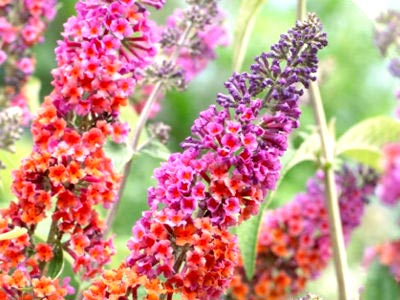
Without exception, all types of buddleia differ in the color of the inflorescences and frost resistance. The height and width of the shrub is also different for different species. The most popular types:
- buddley of David;
- buddley spherical;
- buddleya is alternate-leaved;
- buddleya weyr.
These types of shrubs need similar care, with some fine details.
Buddley of David
The traditional type of plant is a vast bush, the height of which can reach up to three meters. The lower branches are slightly drooping. The root concept is shallow. For the purpose of constant flowering, faded panicles must be carefully removed.The first flowering of this species occurs three years after planting. During the season, the plant grows up to two meters in height. Provides small seeds each fall, multiplies with cuttings. For proper growth, a number of requirements must be met:
- Plant only on the sunny side;
- The soil should be rich in lime;
- Carry out constant irrigation and watering;
- Feed the soil with fertilizers as needed;
- When preparing for winter, insulate.
Japanese buddleya
The homeland of the Japanese buddleya, as the name implies, is Japan. The shrub can reach two to three meters in height. This fast growing deciduous plant has sprawling tetrahedral shoots. It reproduces in the same way as other species. Inflorescences are drooping panicles of a lavender color.

Japanese buddleya
Spherical buddleya
This plant remains green all summer and autumn. It favorably differs from the rest by the unique color of flowers of a colorful yellow hue, which are collected in round, spherical-like inflorescences. The plant exudes a unique tropical scent. The birthplace of the spherical buddley is South America. The only drawback of this species is its inability to frost and lower temperatures. Therefore, in the Russian Federation it is able to grow only in the Caucasus or in artificially created greenhouses and hotbeds.
Spherical buddleya
Definitioner
- Basidia (Basidia)
-
Lat. Basidia. A specialized structure of sexual reproduction in fungi, inherent only in Basidiomycetes. Basidia are terminal (end) elements of hyphae of various shapes and sizes, on which spores develop exogenously (outside).
Basidia are diverse in structure and method of attachment to hyphae.
According to the position relative to the axis of the hypha, to which they are attached, three types of basidia are distinguished:
Apical basidia are formed from the terminal cell of the hypha and are located parallel to its axis.
Pleurobasidia are formed from lateral processes and are located perpendicular to the axis of the hypha, which continues to grow and can form new processes with basidia.
Subasidia are formed from a lateral process, turned perpendicular to the axis of the hypha, which, after the formation of one basidium, stops its growth.
Based on morphology:
Holobasidia - unicellular basidia, not divided by septa (see Fig. A, D.).
Phragmobasidia are divided by transverse or vertical septa, usually into four cells (see Fig. B, C).
By type of development:
Heterobasidia consists of two parts - hypobasidia and epibasidia developing from it, with or without partitions (see Fig. C, B) (see Fig. D).
Homobasidia is not divided into hypo- and epibasidia and in all cases is considered holobasidia (Fig. A).
Basidia is the place of karyogamy, meiosis and the formation of basidiospores. Homobasidia, as a rule, is not functionally divided, and meiosis follows karyogamy in it. However, basidia can be divided into probasidia - the site of karyogamy and metabasidia - the site of meiosis. Probasidium is often a dormant spore, for example in rust fungi. In such cases, probazidia grows with metabasidia, in which meiosis occurs and on which basidiospores are formed (see Fig. E).

See Karyogamy, Meiosis, Gifa.
- Pileipellis
-
Lat. Pileipellis, skin - differentiated surface layer of the cap of agaricoid basidiomycetes. The structure of the skin in most cases differs from the inner flesh of the cap and may have a different structure. The structural features of pileipellis are often used as diagnostic features in descriptions of fungi species.
According to their structure, they are divided into four main types: cutis, trichoderma, hymeniderma and epithelium.
See Agaricoid fungi, Basidiomycete, Cutis, Trichoderma, Gimeniderm, Epithelium.
- Cutis
-
The type of cap skin, consists of creeping non-gelatinized hyphae located parallel to the surface. The surface of the cap looks smooth.
Lat. Cutis.
See Gifa.
Similar species
Poisonous rose-leaf is dangerous for inexperienced mushroom pickers by its similarity with a number of edible species.
- Hawthorn, Clitopilus prunulus Scop. ex Fr. P. Kumm. , mainly differs in the plates descending to the leg, however, it is colored in almost the same way as poisonous pink plate.
- Edible rose leaf garden, Entoloma clypeatum (L.) P. Kumm. ) differs from the poisonous rose-platypus mainly in the hygrophilous cap and in the place of growth - it is found in gardens and meadows, and not in deciduous forests.
- The May row, Calocybe gambosa (Fr.) Donk, has narrow, frequent hymenophore plates, usually adherent, whitish or light ocher in color.
- Smoky talker, Clitocybe nebularis (Batsch) P. Kumm. , differs in narrow, frequent plates of whitish or cream color, weakly descending along the stem and easily separating from the cap. It also has a peculiar floral or putrid smell.
- Row pigeon, Tricholoma columbetta (Fr.) P. Kumm. , has a silky-white cap with colored spots and a flesh that turns pink on the cut.
- The common champignon, Agaricus campestris L., is easily distinguishable from the poisonous rose leaf due to the presence of a ring on the stem and darker plates.
Of the poisonous mushrooms, the related entoloma is pressed down, Entoloma rhodopolium (Fr.) P. Kumm, is very similar to the poisonous rose leaf. ), which is also poisonous.
Entoloma poisonous
Poisonous entoloma - lat. Entoloma sinuatum
In a different way, a dangerous mushroom is called Entoloma tin, Rosovoplastinnik gigantic, Rosovoplastinnik poisonous, Entoloma notched-lamellar, or Rosovoplastinnik yellowish-glaucous.
Mushroom cap
Pewter entoloma builds up a giant cap with a diameter of up to 25 cm. The hats of young mushrooms at first have a convex rounded or bell-shaped shape, after which they spread out or remain convex-flat.
The edges of the caps are at first tucked up, as they mature, they are lowered, even or wavy. In the center of the mushroom, a sloping mound is preserved; in old mushrooms, a notch often appears.
The glossy silky skin becomes sticky in wet weather. It is painted gray-ocher or grayish-white, with age turning into a gray-brown shade with an ash tint.
The inside of the hats has a fleshy white flesh that turns brown under the skin and does not change color after damage. The flesh of a young pink-colored plate smells like flour, while old mushrooms exude a rancid odor. It is tasteless or has a bitter taste.
The bottom of the hat is speckled with weakly growing thin plates 8-15 mm wide. Young plates are grayish-yellow in color, while mature ones are pink or reddish with a dark edge.
Giant pink laminae reproduces by angular spores, forming them in pink spore powder.
Stipe
Entoloma poisonous has a powerful cylindrical or clavate leg, bending downward, the diameter of which is 10-35 mm, and the length is 40-150 mm. At a young age, the legs are filled with pulp, which later turns into a spongy mass.
The leg is covered with a smooth silky white skin that turns gray or yellow with time. If you press on it, it will turn slightly brown. The lower part remains smooth, the upper part is covered with a mealy bloom.
Entoloma poisonous (Entoloma sinuatum)
Growing places
Poisonous rose-leaf is a rare mushroom that prefers heavy clay or limestone soil of light deciduous and mixed forests and parks with beech, oak, hornbeam, willow and birch trees. It is found in the South Siberian, North Caucasian and European parts of Russia, as well as in Ukraine.
Single and numerous fruiting occurs at the end of May - beginning of October.
Edibility
The name of the mushroom speaks for itself: Poisonous entoloma is very toxic. Its use causes severe food poisoning, accompanied by fever, vomiting, abdominal pain, etc. If you eat a large number of mushrooms, you can die.
How to cook properly
As a rule, the legs of the sublivings are not used for food purposes, which is due to the excessive rigidity of this part of the fruiting body. The fruit bodies of Entoloma clypeatum can be fried, used for soups and harvested for winter by pickling. The collected mushrooms should be carefully sorted out and washed, then carefully peeled and boiled until tender. Mushrooms that have undergone this preliminary preparation can be fried or used for other cooking methods.
Also Entoloma clypeatum is very well suited for pickling and pickling applications. In this case, preliminary soaking is not required, but the boiling process is mandatory. Salting can be carried out both by a long-term method according to a traditional recipe using oppression and salting for 30-40 days, or by a high-speed method according to a recipe for preparing russula. To this end, you need to boil the previously prepared fruit bodies a couple of times, then rinse and, pouring clean water, cook for about an hour, then salt and add chopped garlic, as well as dill seeds. The mushrooms are placed under oppression and placed in the refrigerator for a couple of days, after which the dish will be completely ready for use.
Description of poisonous entoloma
Entoloma venomous is the largest member of the genus. The diameter of its cap is most often 5-17 centimeters, but can reach 25 centimeters. The color of the cap in young specimens ranges from grayish-ocher to off-white; with age, the color becomes ash or gray-brown. The cap is smooth, sometimes there may be small folds in the central part. In wet weather, the cap becomes a little sticky, and when it dries, it becomes shiny.
The shape of the cap at a young age is hemispherical, it can be conical-bell-shaped with a rolled edge, over time it becomes flat-convex with a blunt wide tubercle in the center and a wavy or even edge, and in very old mushrooms it can become sunken.
The flesh of the rose leaf is thin and dense. At a break, the color of the pulp does not change. The taste is unpleasant and the odor can be mealy or rancid. The blades are sparse, wide, notched or with weakly adherent teeth. The color of the plates is first dirty yellow, then yellow-pink, pinkish or red, while the edges are darker.
The height of the leg of the poisonous entoloma ranges from 4 to 15 centimeters with a thickness of 1-3.5 centimeters. The stem is central, cylindrical, most often curved and thickened at the base. At first, the leg is dense, but in adulthood it becomes spongy. The surface of the leg is silky, white, and later grayish or ocher-yellow. If you press on the leg, it will turn pale brown. In the upper part of the leg there is a mealy bloom, and below it is naked.
Spore powder of pink color. Spores are hexagonal, slightly elongated, pink-yellow in color, smooth, with one or two drops of oil.
Ecology and distribution of the poisonous rose-leaf
Poisonous entoloma is a relatively rare fungus that grows sparsely. These mushrooms grow in the soil. The fruiting season begins at the end of May. They are found in mixed and deciduous forests, most often in parks and oak forests.
They form mycorrhiza with beech, oak, hornbeam, and in more rare cases - with willow and birch. Poisonous rose-leafed plants prefer heavy soils with a high lime content. These mushrooms live singly or in small groups. This is a thermophilic type of mushroom. On the territory of our country, they are found in the south of the European part and the northern Caucasus, and also grow in the south of Siberia.
Toxicity of the giant rose-leaf
It is a gastrointestinal poisonous fungus that, when eaten, irritates the gastrointestinal tract. Poisonous entoloma provokes a resinoid syndrome, accompanied by vomiting, abdominal pain and loose stools. These symptoms appear already after 30 minutes - 2 hours after the ingestion of toxins.It all starts with a headache and dizziness, and then diarrhea and severe vomiting are added.
As a rule, recovery occurs after 48-72 hours, but if a person has eaten a large amount of poisonous mushrooms, death can occur.
Poisoning treatment
Treatment consists in gastric lavage and the appointment of saline-type laxatives, as well as enterosorbents.
If severe gastroenteritis has developed, saline and glucose are administered to the victim. In addition, everyone else who used poisonous entoloma, and who did not show symptoms of poisoning, also washed the stomach and prescribed laxatives and enterosorbents.
Similar species
The danger of the rosacea lies in its resemblance to a number of poisonous mushrooms:
• The edible rose-leaf garden can be distinguished from its poisonous counterpart thanks to its hygrophilous cap and habitat - these mushrooms grow in meadows and gardens, and not in forests;
• Hanging plant is recognized by the plates descending to the leg, but its color is practically the same as poisonous entoloma;
• May ridge is characterized by frequent, narrow blades, mostly adherent, of light ocher or whitish color;
• The pigeon row is distinguished by a silky white cap with colored spots and flesh, which becomes pink on the cut;
• Smoky talker has narrow, often spaced cream or whitish plates, which slightly descend along the stem and are easily separated from the cap. The smoky talker smell can be floral or putrid;
• The common champignon can be easily distinguished from the poisonous rose-leaf with the help of the ring on the stem and the plates of a darker color;
• The pigeon row is characterized by a silky cap with colored spots and a pinkish flesh on the cut.
Among poisonous mushrooms, the greatest similarity is observed with the pressed entola. But the entholoma pushed through, just like the poisonous rose-leaf, is not harvested, so it is not scary to confuse these mushrooms.
Description
The largest representative of the genus entolom.
The hat is 5-17 (up to 25) cm in diameter, in young mushrooms - from dirty-white to gray-ocher, in maturity - gray-brown, ashy, smooth, sometimes finely folded in the center, slightly sticky in damp weather, shiny when dry ... In young mushrooms, the cap is hemispherical or conical-bell-shaped with a tucked edge, retaining this shape for a long time, later it is flat-convex or prostrate with a lowered even or wavy edge and a wide blunt tubercle in the middle, sometimes in old specimens it is sunken, irregularly rounded.
The pulp is white, thick, firm. Does not change color when broken. The taste is described as slurred or unpleasant; the smell is mealy or rancid.
8-15 mm wide, wide, sparse, poorly adherent toothed or notched, weakly sore; first dirty yellow, later yellowish pink, pink or reddish, with darker edges.
Leg 4-15 cm high and 1-3.5 cm thick, central, usually curved at the base, cylindrical, sometimes compressed, often thickened towards the base, dense, but tapering downwards again; in young mushrooms it is solid, at maturity with a spongy filling. The surface of the leg is white, silky, later ocher-yellowish or grayish, when pressed - pale brownish; mealy above, naked below.
Spore powder pink. Spores 8-11 x 7-9.5 microns, hexagonal, isodiametric (rounded) or slightly elongated, smooth, pinkish-yellow, with 1-2 drops of oil. Basidium with 4 basidiospores. Cystyds are absent. The surface of the cap is ixokutis, consisting of narrow, cylindrical hyphae 2-5 microns thick with buckles. The pigment is very light, intracellular.
A form devoid of yellow hymenophore coloration is rare, but found in Austria, France and the Netherlands.
Description of the garden entoloma.
In adolescence, the cap is bell-conical, it can be convex, then it becomes prostrate or concave, often a tubercle remains in the middle.Its diameter is generally 7-10 centimeters, and sometimes it reaches 12 centimeters.
The surface of the cap is smooth, after rain it becomes sticky and darker, and in sunny weather it is lighter, silky-fibrous. The edges of the cap are uneven, wavy, and may be cracked. The color of the cap is whitish-gray, gray-brown, beige or gray-brown.
Under the hat of the garden entoloma there are wide plates. They are located quite rarely. They grow to the peduncle with a jagged edge. The length of the plates is not the same. In young fruit bodies, the plates are whitish, later become dirty pink, pale pink or gray-brown, and in the old plates a reddish tint appears. The pink shade of the plates is a distinctive feature for all members of the genus. The spore powder is also pink.
The pulp of this mushroom is soft, but dense, fibrous. The color of the pulp is white or brownish. The pulp has a faint mealy smell and taste, and sometimes it is completely bland.
The stem is cylindrical, often curved and twisted. Its height reaches 10-12 centimeters, and the girth ranges from 1 to 2 centimeters, rarely reaching 4 centimeters. The structure of the leg is fragile, longitudinally ribbed. At first it is solid, but in old age it becomes hollow. Slightly furrowed under the head of the knife. The color of the leg is whitish, pink or grayish. Its base is slightly thickened and lighter. There is no ring on it.






